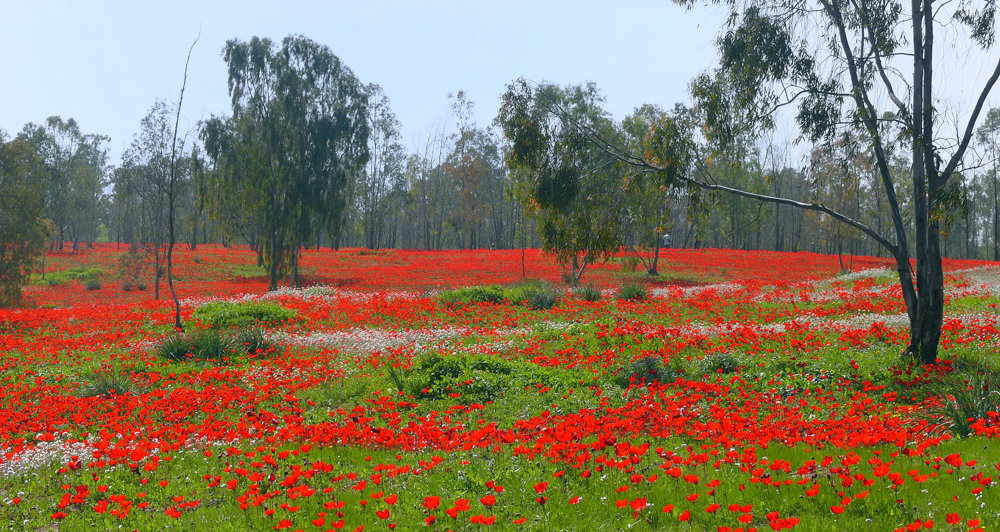The fascinating flower story of a poppy and a kalaniyot
“Kalaniyot” was the signature song of the wildly popular Israeli singer Shoshana Damari, who died in 2006. Designated as Israel’s national flower in 2013, it is usually translated as “poppy” in English.
Spring arrives earlier in Israel than in New York, and by February, kalaniyot can be seen throughout the country, although it is a particular tourist attraction in the Eshkol region of the northwest Negev, where it is colloquially called darom adom. In Hebrew, darom refers to cardinal direction south, and adom means “red,” so darom adom can be freely translated as “the south is awash in red.”
After the winter rains, that image is vibrantly true. Green grass covers the fields intermixed with multitudes of kalaniyot. Closer examination, however, made it clear that these are not poppies — family Papaveraceae, genus Papaver. Instead, they are Anemone coronaria, family Ranunculaceae.
Löw Immanuel was a Hungarian rabbi interested in rabbinic lexicography (the compiling of dictionaries), and the identification of many plants referenced in the Hebrew Bible and the Talmud using the latest scientific information of his time. Knowing that the Talmud was written in Aramaic explains the title of his doctoral thesis, itself written in German — “Aramaeische Pflanzennamen,” or “Aramaic Plant Names.”
His work deeply influenced that of Yehuda Feliks, considered today to be one of the greatest scholars of Jewish botany.
The kalanit (singular form) was named by Immanuel based on two sources. It was likely that this is the same flower mentioned in the Talmud as klonita. In addition, the Hebrew word for “bride” is kalla, and the name plays on the concept that all brides are radiant.
Anemone tubers can be bought in the United States, and are referred to as wind flowers. That designation is based on the Greek, where anemoi means “wind,” and one means “daughter of.” Despite that name, a Greek myth tells of the handsome Adonis who died in the arms of his beloved Aphrodite after being gored by a boar. Her tears and his blood mingled on the ground and gave birth to the red anemones.
While purple, white and blue kalaniyot grow in northern Israel, the southern plants only bloom red. This red color dominance seems to correlate with the area’s greater aridity. Each flower blooms for a few weeks, opening and closing with the sunlight, tracking the sun throughout the day.
Anemone coronaria also can be found in Greece, Turkey as well as throughout the Middle East.
Poppies, however — known as pereg in Hebrew — grow in abundance all over Israel. Altogether, nine different species can be found, most beginning their bloom season in March, and none lasting past June. Different species have different ranges, but the only area that doesn’t support a population is the Negev. This genus is originally native to cold and temperate regions of Eurasia, Africa and North America.
The poppy is a favorite in spring gardens in the United States as well. However, it is the Papaver somniferum — somniferum meaning “sleep-bringing” in Latin — and the ancient Sumerians call Hul Gil (the flower of joy) that brings mixed blessings. The oozing sap that can be collected from seed pod after the flowers fall away is the source of opium.
While it is legal to buy seed in the United States and grow the flowers, it is illegal to grow them with the intent of producing opium.
However, these self-same poppies also are grown for three additional — and non-problematic — purposes. The same seed pods that can yield opium, if left to grow undisturbed, are intricately beautiful and prized for use in dried botanical arrangements.
Additionally, these seed pods — again, if left undisturbed — are the source of poppy seeds used in baking and confectionary. Often, the seeds are only used decoratively, as when added to the glaze on bread and rolls. The flavor is significantly more intense when grounded and made into a paste, and appears frequently in Jewish and Eastern European baking, as well as Indian cuisine.
The seeds are so tiny that it takes between 1 million and 2 million of them to make up a pound.
The aromatic chemical responsible for its unique flavor is 2-pentylfuran, which also can be found in other foods, including coffee, potatoes, roasted filberts and soybean oil.
Finally, the seeds yield 45 to 50 percent oil when pressed. It has culinary and pharmaceutical uses as well as uses in paints, varnishes and soaps.
Despite the insignificant levels of opiates in the poppy seeds themselves, eating them can cause a false positive in a drug test. Because of this effect, the federal guidelines that constitute opioid levels had to be raised to distinguish a drug user from a poppy seed eater.
Who knew?
Have a thought or comment for Sura Jeselsohn? Email her at greenscenesura@gmail.com.






